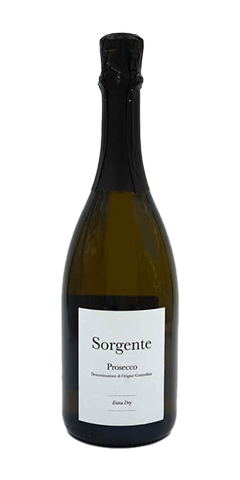
Sorgente Prosecco Extra Dry
$ 16.99
Sorgente Prosecco comes from a six hectare parcel of Glera vines located in Friuli-Venezia Giulia. The vineyards sit only a few hundred meters from the natural spring (called sorgente in Italian) at the nascita of the Livenza River.
The proximity to the Alps (which begins no more than ten miles to the north) and the Adriatic (twenty miles away) brings an ideal temperature characterized by large diurnal swings from day to nighttime. As you all know, this is crucial for the development of complex phenolics, fresh acidity and elevated aromatics—all necessary for a proper Prosecco to remain true to form (bright, fresh, minerally) and function.
The vineyard soils are endowed with limestone and clay, both a mixture of the former salty marshland that existed here millions of years ago (just like much of France’s limestone spots—Burgundy, Loire Valley, Jura, etc), along with alluvial soils largely composed of limestones deposited by the Livenza and the neighboring river, Meduna. From a pedigree standpoint, there is good reason that one would discover the mineral nuances of this “simple” Prosecco due to its soil composition and climatic balance. In most clay based soils (which is true in this case) the development of the grapes is longer on the vine, which further contributes to the layers of potential complexity and unexpected ageability for a Prosecco.
They have abandoned herbicides and pesticides completely. All in the vineyard is managed by hand and the soil tilled by machine, with only vineyard treatments of copper and sulfur—standard and obligatory (if you actually want to have grapes) in European vineyards farmed with any method whether it be sustainable, organic, biodynamic and the less clearly defined “natural.”
The sparkling process is made when needed and performed in an autoclave (high pressure tank) by adding sugar and selected neutral yeasts to finish the job. (Primary fermentation is natural yeast and second is cultured; that said, the wine’s aromatic components—both the nose and palate—have already been developed prior to the use of cultured yeast, which serve the function of quickly turning the sugar into CO2 gas and alcohol—the amount of sugar converted only amounts to a single degree of alcohol, therefore the influence of the cultured yeast at this point in the game is relatively inconsequential.) The wine is brought to 15/17°C and kept constant for more or less 20 days. Once the desired pressure and residual sugar is obtained, the fermentation is stopped by bringing the temperature down to 2°C. The wine will be kept in contact with the fine lees—a combination of natural and to a much lesser degree, cultured—for more or less 60 days, with weekly bâtonnage to bring texture to the palate. During this two-month period the wine develops its complex and textured mouthfeel from the lees as well as smaller more fine bubbles than those that are bottled immediately and sent to market.
Due to the residual sugar content (like all wines with a notable sugar content) the wines are filtered. The residual sugar for the Extra Dry is 12g/l and the Brut, 5g/l. The acidity of both ranges between 5.8-6.0g/l with a finishing pH typically landing at 3.25. Total SO2 is never more than 120mg/l and the alcohol is 11.5%. -TV
Italy, Friuli-Venezia Giulia
100% Glera
11.5% Alcohol
An adult signature is required upon delivery, so please keep that in mind when shipping this gift to friends, family and peers.
There is no minimum.
Bottles are in perfect condition.
